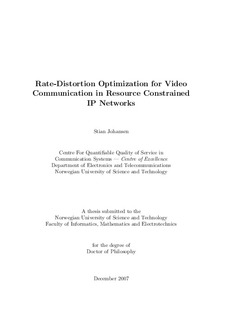| dc.contributor.author | Johansen, Stian | nb_NO |
| dc.date.accessioned | 2014-12-19T13:42:35Z | |
| dc.date.accessioned | 2015-12-22T11:39:47Z | |
| dc.date.available | 2014-12-19T13:42:35Z | |
| dc.date.available | 2015-12-22T11:39:47Z | |
| dc.date.created | 2008-03-31 | nb_NO |
| dc.date.issued | 2008 | nb_NO |
| dc.identifier | 123893 | nb_NO |
| dc.identifier.isbn | 978-82-471-7300-8 | nb_NO |
| dc.identifier.uri | http://hdl.handle.net/11250/2368811 | |
| dc.description.abstract | Resource limitations lead to a number of challenges in all communication systems. This is also the case for video communication over networks based on the Internet Protocol (IP), where limited rates are shared among competing, heterogeneous users. Packet losses, delays and connectivity losses will be experienced to a varying degree depending on network loads, physical properties and mobility-related issues. These factors, as well as source coding characteristics, in source the visual quality experienced by the users.
One of the main contributions of the work presented in this thesis is that performance gains can be attained when considering characteristics of source coding, networks and congestion control jointly. Throughout the presented work, optimization of visual quality is at the centre of attention. The thesis is divided into three main parts, with contributions as follows.
Part A deals with rate-distortion optimized packet loss protection when communicating video over multiple channels simultaneously. Source coder characteristics and characteristics of the (logically or physically) different channels are taken into account in order to yield an optimized packet loss protection of the video. This part presents different optimization algorithms, which are in turncompared in terms of both performance and complexity.
Part B uses the algorithms of part A in the context of congestion control. Specifically, the potential problem of misbehaving receivers is considered. In current systems, there exists an incentive for non-conformant congestion control by video receivers in that an improved video quality can be achieved through obtaining an unfairly high bandwidth share. Since this has unfortunate effects on the connection characteristics of competing users, it poses a potential problem for mass deployment of UDP (User Datagram Protocol) based video services. In this work, a joint source-channel coding based framework which removes the incentive for bandwidth `greediness' is introduced. Specifically, the framework attempts to reverse the situation and provide an incentive in terms of visual quality for adhering to congestion control guidelines for fair bandwidth sharing. The framework is developed for both unicast and multicast cases, and is presented along with optimization algorithms and simulation results.
Part C considers real-time video delivery in mobile ad-hoc networks. As this type of networks exhibit rather harsh characteristics in terms of throughput, packet losses and mobility-induced route losses, new solutions are required. The approach taken in this work is based on a distributed rate-distortion optimization framework, where multiple sources are used concurrently. The system uses scalable video coding and rateless channel codes in order to allow for uncoordinated sources and distributed optimization. The complete system is implemented in a network simulator, and is shown to exhibit considerable performance gains compared to previous proposed systems. | nb_NO |
| dc.language | eng | nb_NO |
| dc.publisher | Fakultet for informasjonsteknologi, matematikk og elektroteknikk | nb_NO |
| dc.relation.ispartofseries | Doktoravhandlinger ved NTNU, 1503-8181; 2008:67 | nb_NO |
| dc.title | Rate-Distortion Optimization for Video Communication in Resource Constrained IP Networks | nb_NO |
| dc.type | Doctoral thesis | nb_NO |
| dc.contributor.department | Norges teknisk-naturvitenskapelige universitet, Fakultet for informasjonsteknologi, matematikk og elektroteknikk, Institutt for elektronikk og telekommunikasjon | nb_NO |
| dc.description.degree | PhD i informasjons- og kommunikasjonsteknologi | nb_NO |
| dc.description.degree | PhD in Information and Communications Technology | |
